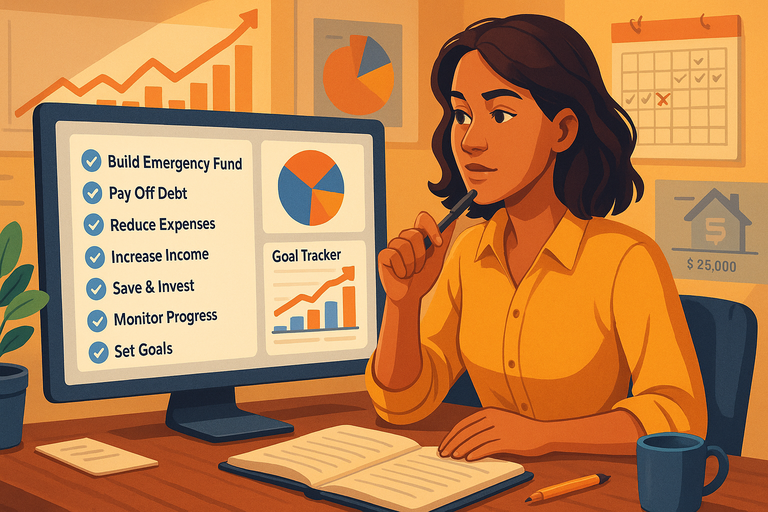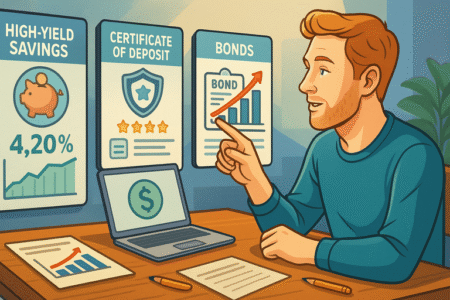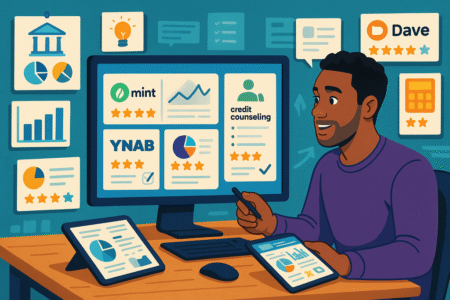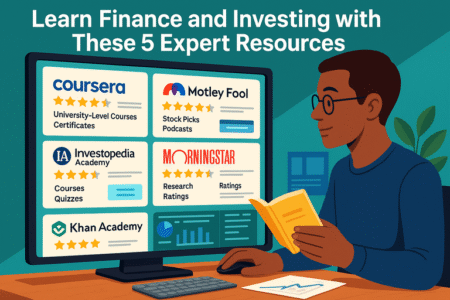Table of Contents
Achieve financial freedom—it’s a phrase we hear often, but what does it really mean for you? Is it about paying off debt, building multiple income streams, or finally reaching a point where work becomes a choice, not a necessity?
The truth is, financial freedom looks different for everyone, but the steps to get there follow a proven path.
In this guide, I’ll break down seven clear and practical steps you can follow to take control of your money, build lasting wealth, and create the lifestyle you want without constant financial stress.
1. Define What Financial Freedom Means To You
Before you can achieve financial freedom, you need to know what it actually looks like for you. For some, it means quitting a job and traveling the world.
For others, it’s about paying off the mortgage early and building generational wealth. The point is—financial freedom isn’t one-size-fits-all.
Clarify Your Personal Financial Goals
Start with the basics: what do you want money to do for you? A goal is not just “I want to be rich.” That’s vague, and vague goals rarely stick. I recommend breaking it down into categories like:
- Short-term goals: Saving $5,000 for a travel fund, building a 3-month emergency cushion, or paying off a small credit card.
- Mid-term goals: Buying a home, funding a child’s education, or starting a business.
- Long-term goals: Hitting a $1M retirement portfolio, living debt-free, or creating passive income streams that cover all expenses.
What works well is writing these out as SMART goals—Specific, Measurable, Achievable, Relevant, and Time-bound. Instead of “I want to save money,” write: “I want to save $15,000 in the next 18 months for a down payment.”
Identify Lifestyle Priorities That Matter Most
This is where most people trip up. They chase numbers without thinking about the life they actually want to live. I’ve seen people grind for years only to realize they built wealth but burned out their health and relationships along the way.
Ask yourself questions like:
- Do I want the flexibility to work less and spend more time with family?
- Would I rather invest in travel experiences or own luxury items?
- Am I aiming for early retirement, or do I want work that I love so much I’ll do it into my 70s?
One practical exercise is to imagine your perfect week five years from now. What does it look like? Who are you spending time with?
How many hours do you work? What kind of home do you live in? Writing this down gives clarity to your financial targets.
Set A Timeline For Your Financial Vision
Without a timeline, financial freedom is just a wish. A timeline creates urgency and forces you to prioritize. I suggest breaking your vision into three buckets:
- 1–3 years: Build savings, crush high-interest debt, and stabilize your budget.
- 5–10 years: Grow investments, buy assets, and create multiple income streams.
- 15+ years: Reach full financial independence where your assets cover your lifestyle.
Timelines aren’t rigid, but they’re a map. Even if you don’t hit every milestone perfectly, you’ll be far ahead of drifting without one. Think of it like setting a GPS—you can always reroute, but you need a destination in the first place.
2. Build A Strong Budget That Actually Works
If defining financial freedom is the vision, then your budget is the engine that drives you there. A budget isn’t about restriction—it’s about control. Done right, it gives you permission to spend on the things you value most without guilt.
Track Your Spending With Real Numbers, Not Estimates
Here’s the mistake most people make: they guess. They’ll say, “I think I spend about $300 on groceries” when in reality it’s $550. The problem with guesses is they build a fantasy budget.
Instead, pull your last three months of bank and credit card statements. Categorize everything: housing, food, transport, entertainment, subscriptions, and so on. You might be shocked at how much slips away on things you barely notice.
I once realized I was spending $180 a month on coffee and snacks at gas stations—that’s $2,160 a year.
By using real numbers, your budget stops being theory and becomes a mirror of your actual life.
Create A Zero-Based Budget To Maximize Every Dollar
A zero-based budget simply means you assign every single dollar a job before the month begins. Income minus expenses equals zero. That doesn’t mean you spend it all—it means you give every dollar a purpose, whether that’s rent, groceries, savings, or debt payoff.
For example, if you earn $4,000 in a month:
- $1,200 goes to rent
- $500 to groceries
- $400 to transportation
- $800 to debt repayment
- $500 to savings
- $400 to discretionary spending
- $200 to investments
Now, your money is working with intention instead of slipping through the cracks.
I recommend starting with your non-negotiables (housing, utilities, food), then funding your goals (savings, debt, investing), and only then adding the extras like streaming services or dining out.
Use Budgeting Tools To Stay Consistent And Motivated
Tracking manually works, but tools make life easier and more motivating. Apps like YNAB (You Need A Budget), Mint, or EveryDollar give you dashboards that show exactly where your money is going in real time.
- YNAB is amazing for zero-based budgeting—it forces you to assign every dollar.
- Mint automatically syncs with accounts and gives spending insights.
- EveryDollar is simple and clean, perfect if you don’t want bells and whistles.
Personally, I suggest starting with just one tool. Don’t overwhelm yourself by trying them all. Pick the one that feels natural and stick with it for at least three months. Consistency is where the real results show up.
A great tip: set a 20-minute weekly “money date” with yourself (or your partner). Review spending, check progress toward goals, and adjust for any surprises. This small ritual prevents financial drift and keeps your budget alive instead of forgotten in a spreadsheet.
3. Eliminate High-Interest Debt Strategically
High-interest debt is the single biggest enemy of financial freedom. If your credit card charges 20% interest, you’re digging in quicksand.
No matter how much you invest or save, compounding works against you when debt grows faster than your money.
Understand The True Cost Of Carrying Debt
Debt feels like just another monthly payment—until you look closer. Let’s say you carry a $5,000 credit card balance at 22% interest and only make minimum payments.
Do you know how long it would take to pay off? Nearly 18 years. And you’d hand over about $6,500 in interest—more than the original balance.
This is why I suggest looking beyond the “monthly payment” mindset. That number lulls you into thinking debt is manageable. Instead, focus on the total interest you’ll pay over time.
Most credit card statements even include a line that says, “If you only make minimum payments, you’ll pay X over Y years.” That’s the real cost of carrying debt.
Choose Between Debt Avalanche And Debt Snowball Methods
When it comes to paying off debt, you need a system—not random extra payments whenever you remember. Two proven methods dominate the conversation:
- Debt Avalanche: Pay off debts with the highest interest rate first while making minimums on others. This saves the most money in interest over time.
- Debt Snowball: Pay off the smallest debt first for a quick win, then roll that payment into the next debt. This builds motivation and momentum.
If you’re analytical and motivated by math, I recommend the avalanche. If you’re more motivated by small victories (and honestly, many of us are), snowball works better.
I used a hybrid once: I tackled a $1,200 credit card first just for the emotional win, then shifted into avalanche mode. The psychological relief of knocking one balance to zero gave me firepower to stay disciplined.
Negotiate Interest Rates Or Consolidate For Faster Payoff
Here’s a trick many people overlook: you can negotiate your debt. A five-minute phone call to your credit card company asking for a lower rate often works—especially if you’ve been a customer in good standing.
Even dropping your APR by 3–5% can shave months off your payoff timeline.
Another option is debt consolidation. You can:
- Transfer balances to a 0% APR card (intro offers usually last 12–18 months).
- Take out a personal loan with a lower rate and fixed payments.
- Refinance high-interest debt into something more manageable.
But here’s the catch: consolidation isn’t an excuse to keep spending. If you don’t fix the behavior, you’ll end up with double the debt. My rule of thumb: only consolidate if you’re committed to cutting off new spending until balances are gone.
4. Establish An Emergency Fund As A Safety Net
Once high-interest debt is under control, your next move is building an emergency fund. Think of it as your financial shock absorber.
Life happens—cars break down, jobs get lost, water heaters explode at the worst possible time. Without a cushion, you end up right back in debt.
Decide On The Right Size For Your Emergency Fund
There’s no universal number because life circumstances vary. A single person with low expenses may only need three months’ worth of essentials. A family with kids and one income might feel safer with six months or more.
Here’s a simple framework I advise:
- Starter fund: $1,000–$2,000 just to stop using credit cards for emergencies.
- Core fund: 3 months of bare-bones living expenses.
- Full fund: 6+ months of expenses for maximum stability.
The point is not perfection but progress. Even a $500 cushion can turn a car repair from a crisis into an inconvenience.
Automate Savings To Build Your Fund Faster
Most people fail at saving because they wait until “money is left over.” Spoiler: it never is. The trick is to automate. Set up a transfer the day after your paycheck hits. Even $50 or $100 consistently adds up faster than you think.
Here’s how I like to do it:
- Log into your bank app.
- Create an automatic transfer from checking to savings every payday.
- Treat it like a bill you owe yourself.
This “set it and forget it” system works because it removes willpower from the equation. I’ve seen people surprise themselves by saving $3,000 in a year without even noticing it leaving.
Keep Emergency Money Accessible But Separate From Daily Accounts
One mistake is keeping emergency savings in the same account as spending money. If your emergency fund lives right next to your debit card, temptation creeps in. “Technically, I could dip into it for that vacation.” That’s how goals evaporate.
Instead, keep it slightly out of reach but not locked away:
- A high-yield online savings account works great. It earns interest and takes 1–2 business days to transfer.
- Avoid tying it to investments like stocks. Emergency money isn’t about growth—it’s about safety.
Think of it like a fire extinguisher: you want it close enough to grab quickly but not sitting on the kitchen counter where you’ll spray it on every little flare-up.
Pro tip: Build your starter emergency fund before going “all-in” on investing. It’s far better to earn 0.5% on cash that saves you from credit card debt at 20% than to chase returns while staying financially vulnerable.
5. Invest Early And Consistently For Long-Term Wealth
Investing is where your money stops working for someone else and starts working for you. To achieve financial freedom, you don’t need to time the market perfectly—you need to get in, stay in, and let time do its work.
Leverage The Power Of Compound Growth Over Time
The earlier you invest, the less you have to contribute over time. Why? Compound growth. This is the snowball effect where your earnings generate more earnings.
For example, if you invest $200 per month starting at age 25 with an average 7% return, you’ll have about $240,000 by age 55. Wait until 35 to start? You’ll only have around $120,000. Ten years costs you half your future wealth.
That’s why I tell people: don’t obsess over how much you can invest at first. Focus on starting, even if it’s just $50 a month. The consistency is what unlocks long-term wealth.
Diversify Across Stocks, Bonds, And Real Estate
Putting all your money into one investment is like walking a tightrope with no safety net. Diversification spreads risk.
- Stocks: Higher risk, higher reward. Over time, they average around 7–10% returns. Great for long-term growth.
- Bonds: Lower risk, lower reward. They add stability to your portfolio.
- Real estate: Rental properties, REITs (real estate investment trusts), or even fractional property investing can provide income plus appreciation.
I suggest using index funds or ETFs (exchange-traded funds) to instantly diversify. Instead of picking one company’s stock, you own tiny slices of hundreds. It’s cheaper, simpler, and has historically outperformed most stock pickers.
Automate Contributions To Retirement And Brokerage Accounts
Automation is the secret weapon of successful investors. From your 401(k) to an IRA or taxable brokerage account, set it so money is invested automatically after every paycheck.
Example: in most 401(k) dashboards, you can set contributions to auto-invest into your chosen funds. In apps like Vanguard, Fidelity, or even Robinhood, you can schedule recurring deposits weekly or monthly.
This removes human error and temptation. You don’t have to decide every month whether to invest—you already decided once. Over decades, this automation will quietly grow into wealth you couldn’t imagine.
6. Create Multiple Streams Of Income
Relying on just one paycheck is risky. If it disappears, your entire lifestyle collapses. Multiple income streams give you flexibility, resilience, and speed up your path to financial freedom.
Build Passive Income Through Side Hustles Or Investments
Passive income isn’t “set it and forget it” magic, but it’s income that eventually requires less effort. Think:
- Rental property cash flow.
- Dividends from stocks.
- Royalties from creative work like books or courses.
If you start a side hustle—say, freelance design—you can reinvest profits into assets that continue to pay you, even when you’re not working.
Explore Digital Income Opportunities For Flexibility
The internet has cracked open new ways to earn. You could:
- Sell templates or digital products on Gumroad.
- Build an audience on YouTube and monetize with ads.
- Offer online coaching in your area of expertise.
The advantage is scalability. A blog post, video, or course can earn money while you sleep. I’ve seen people make more in a month from one digital product than years of hourly side work. It takes effort upfront, but it compounds just like investing.
Reinvest Extra Income Into Wealth-Building Assets
The trap with extra income is lifestyle creep—you make more, you spend more. Instead, redirect new income into wealth-building buckets: investments, paying off the mortgage faster, or building that emergency fund deeper.
A personal tip: every time I added a new stream of income, I committed at least 50% of it to long-term goals. That way, lifestyle upgrades happened slowly, and my wealth snowball grew faster.
7. Protect Your Wealth With Smart Planning
It’s not enough to build wealth—you need to protect it. Unexpected setbacks can wipe out decades of progress if you’re not covered.
Use Insurance To Shield Yourself From Major Setbacks
Insurance is boring—until it saves you from bankruptcy. Health insurance, disability insurance, home/renter’s insurance, and life insurance are all shields.
I’ve seen one medical emergency wipe out families financially because they skipped coverage. Don’t let that be you. Pay for the safety net so one crisis doesn’t undo years of hard work.
Develop A Tax Strategy To Keep More Of What You Earn
Taxes are unavoidable, but overpaying is optional. Smart strategies include:
- Contributing to tax-advantaged accounts (401k, IRA, HSA).
- Tracking deductible expenses if you freelance or run a business.
- Considering Roth vs. traditional accounts based on your future tax bracket.
Even simple moves like maxing out an HSA can save you thousands. It’s triple tax-advantaged: you don’t pay taxes when you contribute, when it grows, or when you use it for medical expenses.
Create A Will Or Trust To Safeguard Your Legacy
Nobody likes thinking about estate planning, but without a will, the state decides what happens to your money and assets. A basic will costs less than a new phone and makes sure your loved ones are cared for.
If you’ve built significant wealth, a trust can also minimize estate taxes and control how your assets are passed down. Think of it as writing the rulebook for your money after you’re gone.
Conclusion With Expert Tip
Financial freedom isn’t about a single big move—it’s about stacking smart decisions over years. You define your vision, budget with intention, crush debt, build savings, invest, grow income, and protect it all.
Here’s my expert tip: focus on momentum, not perfection. Start where you are, even if it’s just $50 toward savings or paying off one credit card. Small consistent actions beat waiting for the “perfect plan.” Over time, those steps compound into freedom—the kind where you decide how your money, time, and life are spent.






